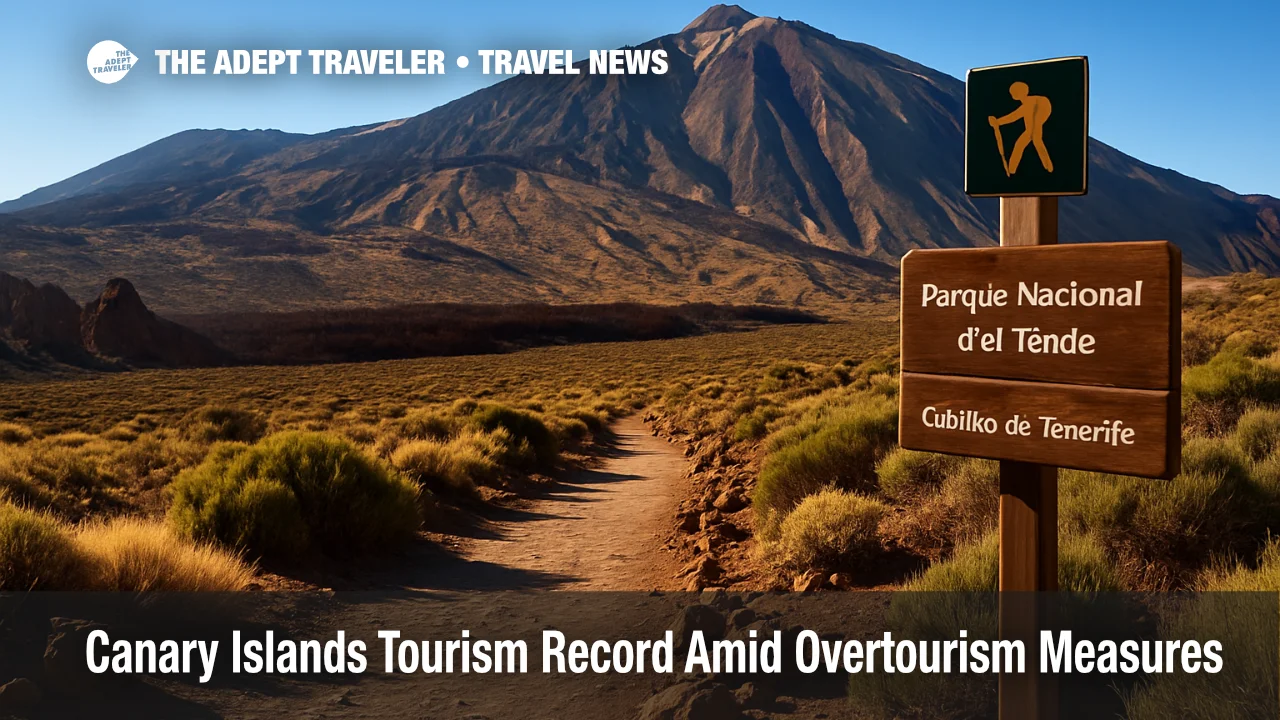Canary Islands set new tourism record as overtourism response ramps up

The Canary Islands posted their busiest August on record for international arrivals, even as resident protests and new management measures expand across the archipelago. Provisional Frontur data show 1.23 million foreign visitors in August, up 6 percent year over year, with 10.3 million internationals from January through August. Regional statisticians say the Canaries ranked third among Spain's destinations over the summer. Officials attribute momentum to reliable air links and year-round sunshine, while acknowledging pressure on housing, parks, and coastal towns.
Key points
- Why it matters: Another Canary Islands tourism record collides with overtourism protests and new controls.
- Travel impact: Expect more fees, permits, and time-slot systems at nature sites, plus tighter rental rules.
- What's next: Tenerife's Teide eco-tax starts in 2026; Spain is delisting non-compliant tourist flats.
- UK leads source markets nationally; Germany remains strong for the islands.
- Mogán in Gran Canaria is charging €0.15 per person, per night after legal green lights.
Snapshot
August brought 1,235,965 international visitors to the Canaries, the most ever for that month, and a 6 percent increase over August 2024. Year-to-date international arrivals reached about 10.3 million through August. Spain as a whole set a national August record with 11.3 million inbound visitors, keeping the United Kingdom as the top feeder market, followed by Germany and France. Tourism's weight in the Canary economy remains outsized, contributing over 35 percent of regional GDP when indirect effects are included. Authorities forecast 18.4 to 18.6 million total visitors for 2025 while accelerating "management over marketing" policies to reduce crowding in protected areas and tourist districts.
Background
Resident pushback has grown since large island-wide demonstrations in 2024 and again in 2025. Complaints center on housing availability and price, water stress, and congestion around natural attractions. Policymakers have responded with a mosaic of tools: municipal nightly fees, smoke-free beaches, alcohol-in-public fines, capacity limits on sensitive trails, and stricter licensing for short-term rentals under Spain's national register. On Tenerife, leaders advanced a new Park Use and Management Plan for Teide National Park that pairs pricing with stricter access controls. Elsewhere, the tourist-heavy municipality of Mogán moved ahead with a nightly per-person fee after court challenges were lifted, positioning the town as an early adopter of local destination-management funding.
Latest developments
Teide eco-tax details: timed access and trail pricing in 2026
Tenerife will introduce a Teide National Park access fee beginning January 2026, with residents of Tenerife and children under 14 exempt, other Canary residents paying a reduced amount, and non-residents paying between €10 and €25 depending on route and guidance. Current published examples include €15 for an unguided ascent on Trail 10 (Telesforo Bravo), €10 with a guide, and €6 on weekdays or €10 on weekends and holidays for Trail 7 (Montaña Blanca-Rambleta). The plan also tightens daily quotas and mobility rules to safeguard the Teide-Pico Viejo ecosystem.
Rental rules, municipal fees, and protests shape the market
Spain's 2025 rental reforms and enforcement drive are shrinking the pool of non-compliant tourist apartments, with thousands to be delisted and steered toward long-term housing. In Gran Canaria's Mogán, a €0.15 nightly per-person fee is now in force for overnight visitors following court back-and-forth, creating a template other municipalities may study. Meanwhile, resident groups continue to pressure island leaders for caps in saturated zones, arguing that unlimited growth is incompatible with finite land and water resources.
Analysis
For travelers and advisors, the message is clear: the Canary Islands remain exceptionally popular, but access is getting more structured. The Teide eco-tax is not just a fee; it signals a shift to timed entries, lower trail capacities, and stricter equipment rules that will reward advance planning. Expect similar systems to expand to other sensitive sites if crowding persists. On lodging, Spain's national register and tougher local enforcement will contract gray-area inventory. That should improve quality control but could push rates higher during peaks. Municipal fees such as Mogán's add a small nightly cost, yet dedicated revenue could stabilize local services that visitors rely on. Air access remains robust, though winter schedules bring selective cuts from ultra-low-cost carriers, so flexibility on airports and dates helps. Big picture, the archipelago is moving from volume to value: fewer unmanaged crowds, more reserves for conservation, and a premium on experiences that tread lightly. Travelers who book licensed stays, budget modest local fees, and pre-book marquee nature days will fare best as the islands calibrate capacity against demand.
Final thoughts
Record arrivals and rising rules can coexist if managed well. The Canary strategy now ties conservation funding and crowd control to high-demand sites while tightening rental compliance in towns under strain. If execution matches intent, visitors will still enjoy beaches, volcanic landscapes, and trade-wind weather, with clearer expectations and healthier ecosystems. For now, the headline stands: another Canary Islands tourism record, and a system evolving to sustain it.
Sources
- Estadística de Movimientos Turísticos en Fronteras (Frontur), agosto 2025, INE
- ISTAC news: turistas en Canarias, agosto 2025 (nota y panel de datos)
- Promotur/ISTAC Frontur brief, agosto 2025 (PDF)
- Gobierno de Canarias: documento clave para regular acceso y conservación del Teide (PRUG)
- Cádiz SER / Radio Club Tenerife: Ecotasa en el Teide, precios y calendario
- Guide to Canary Islands: Teide new rules and prices summary
- Ayuntamiento de Mogán: ordenanza fiscal y anuncio oficial de la tasa turística (PDF y nota)
- Cadena SER Las Palmas: la tasa turística de Mogán vuelve a entrar en vigor (marzo 2025)
- CaixaBank Research: Canary Islands economic outlook, tourism share of GDP
- The Guardian: Canary Islands overtourism protests
